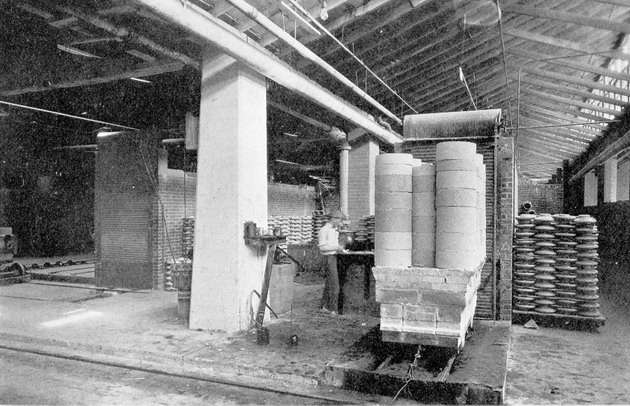Loading the Kiln at Jeffery Dewitt
By Elton Gish; posted August 26, 2007
View Original: Click to zoom, then click to magnify (630 x 406) 109KB

|
The Jeffery-Dewitt Insulator Company took up the development of thick porcelain insulators in a commercial way in 1914, and put its first product on the lines of the Niagara, Lockport & Ontario Power Company in 1915. The company has devoted its entire effort to the production of a single size and design thick porcelain suspension insulator until forced by the demand to bring out post type insulators of the same general characteristics for substation work. The raw materials are purchased and prepared under scientific control, while the body is given its final form in the insulator without being worked in forming machines, pug mills, jiggers or presses. The human element in the J-D process is reduced to the minimum. The drying and firing conditions are shown by recording instruments, with control of these and other steps of the process in the hands of well-trained men. When the ware is in its final form, mechanically sprayed with raw glaze and has passed tests for dryness it is placed in "saggers" on the cars of a modern continuous tunnel kiln. Views of two such kilns are shown. These kilns have proven highly successful for firing thick porcelain because the time element in vitrifying the porcelain at maximum temperature is under accurate control. The rates of heating and cooling are also maintained by controlling the rate at which the long train of small cars is advanced through the tunnel. Temperatures throughout the pre-heating, high temperature and cooling zones of the tunnel are maintained at constant values day after day by the operators with the aid of pyrometric cones on each car and of a large number of indicating and recording pyrometers connected with important points throughout the tunnel. Over a score of kilns of this type are in successful operation in various ceramic and other industries in this country. The number is increasing as rapidly as high first cost and floor space will permit. The two Kenova kilns are over 360 feet long and each has a capacity to produce nearly 1,000 thick J-D porcelains every 24 hours. The tunnel kiln has the advantage for high voltage porcelain that each car carries but a small number of porcelains loaded in such a way that each piece receives uniform heat treatment. This is in contrast with round kilns 16 to 20 feet in diameter, in which there is always a struggle by the kiln burner to fire up the bungs of ware in the center without exposing the outside rings of porcelain to excessive temperature. In these old type kilns some underfiring, overfiring or both are almost unavoidable. The uniform firing of J-D thick porcelain is not taken for granted. Each small car lot is set out after firing and not released for assembly until porosity tests have been made and found satisfactory as described hereafter. The fuchsine-pressure-penetration test, which was developed by this company, has been checked against results obtained in the field with the "megger" and "buzz stick," and has been adopted by power companies and testing departments generally for determining the degree of vitrification required of porcelain for permanent outdoor insulation. (Courtesy of Jimmy Burns; 1923 J-D catalog) |